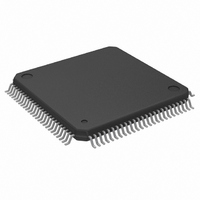M306N5FCTFP Renesas Electronics America, M306N5FCTFP Datasheet - Page 112

M306N5FCTFP
Manufacturer Part Number
M306N5FCTFP
Description
IC M16C MCU FLASH 100QFP
Manufacturer
Renesas Electronics America
Series
M16C™ M16C/6Nr
Datasheets
1.M30622SAFPU5.pdf
(308 pages)
2.M306N5FCTFPUK.pdf
(90 pages)
3.M306N5FCTFPU0.pdf
(408 pages)
Specifications of M306N5FCTFP
Core Processor
M16C/60
Core Size
16-Bit
Speed
20MHz
Connectivity
CAN, I²C, IEBus, SIO, UART/USART
Peripherals
DMA, WDT
Number Of I /o
87
Program Memory Size
128KB (128K x 8)
Program Memory Type
FLASH
Ram Size
5K x 8
Voltage - Supply (vcc/vdd)
4.2 V ~ 5.5 V
Data Converters
A/D 26x10b; D/A 2x8b
Oscillator Type
Internal
Operating Temperature
-40°C ~ 85°C
Package / Case
100-QFP
Lead Free Status / RoHS Status
Contains lead / RoHS non-compliant
Eeprom Size
-
Available stocks
Company
Part Number
Manufacturer
Quantity
Price
Company:
Part Number:
M306N5FCTFP
Manufacturer:
ON
Quantity:
36 000
Company:
Part Number:
M306N5FCTFP#U0
Manufacturer:
Renesas Electronics America
Quantity:
10 000
Company:
Part Number:
M306N5FCTFP#UK
Manufacturer:
XILINX
Quantity:
1 400
Company:
Part Number:
M306N5FCTFP#UK
Manufacturer:
Renesas Electronics America
Quantity:
135
Company:
Part Number:
M306N5FCTFP#UK
Manufacturer:
Renesas Electronics America
Quantity:
10 000
Company:
Part Number:
M306N5FCTFP#UKJ
Manufacturer:
Renesas Electronics America
Quantity:
10 000
- Current page: 112 of 408
- Download datasheet (3Mb)
M16C/6N Group (M16C/6N5)
Rev.2.40
REJ09B0011-0240
12. DMAC
The DMAC (Direct Memory Access Controller) allows data to be transferred without the CPU intervention.
Two DMAC channels are included. Each time a DMA request occurs, the DMAC transfers one (8- or 16-bit)
data from the source address to the destination address. The DMAC uses the same data bus as used by the
CPU. Because the DMAC has higher priority of bus control than the CPU and because it makes use of a
cycle steal method, it can transfer one word (16 bits) or one byte (8 bits) of data within a very short time after
a DMA request is generated. Figure 12.1 shows the DMAC Block Diagram. Table 12.1 lists the DMAC
Specifications. Figures 12.2 to 12.4 show the DMAC related-registers.
Figure 12.1 DMAC Block Diagram
A DMA request is generated by a write to the DSR bit in the DMiSL register (i = 0, 1), as well as by an
interrupt request which is generated by any function specified by bits DMS, and DSEL3 to DSEL0 in the
DMiSL register. However, unlike in the case of interrupt requests, DMA requests are not affected by the I flag
and the interrupt control register, so that even when interrupt requests are disabled and no interrupt request
can be accepted, DMA requests are always accepted. Furthermore, because the DMAC does not affect
interrupts, the IR bit in the interrupt control register does not change state due to a DMA transfer.
A data transfer is initiated each time a DMA request is generated when the DMAE bit in the DMiCON register
= 1 (DMA enabled). However, if the cycle in which a DMA request is generated is faster than the DMA
transfer cycle, the number of transfer requests generated and the number of times data is transferred may
not match. For details, refer to 12.4 DMA Request.
NOTE:
1.Pointer is incremented by a DMA request.
Apr 14, 2006
DMA0 transfer counter TCR0
DMA0 transfer counter reload register TCR0
DMA1 transfer counter reload register TCR1
DMA1 transfer counter TCR1
page 90 of 372
Data bus high-order bits
Data bus low-order bits
Address bus
DMA0 source pointer SAR0
DMA0 destination pointer DAR0
DMA0 forward address pointer
DMA1 source pointer SAR1
DMA1 destination pointer DAR1
DMA1 forward address pointer
DMA latch high-order bits
DMA latch low-order bits
(1)
(1)
12. DMAC
Related parts for M306N5FCTFP
Image
Part Number
Description
Manufacturer
Datasheet
Request
R

Part Number:
Description:
KIT STARTER FOR M16C/29
Manufacturer:
Renesas Electronics America
Datasheet:

Part Number:
Description:
KIT STARTER FOR R8C/2D
Manufacturer:
Renesas Electronics America
Datasheet:

Part Number:
Description:
R0K33062P STARTER KIT
Manufacturer:
Renesas Electronics America
Datasheet:

Part Number:
Description:
KIT STARTER FOR R8C/23 E8A
Manufacturer:
Renesas Electronics America
Datasheet:

Part Number:
Description:
KIT STARTER FOR R8C/25
Manufacturer:
Renesas Electronics America
Datasheet:

Part Number:
Description:
KIT STARTER H8S2456 SHARPE DSPLY
Manufacturer:
Renesas Electronics America
Datasheet:

Part Number:
Description:
KIT STARTER FOR R8C38C
Manufacturer:
Renesas Electronics America
Datasheet:

Part Number:
Description:
KIT STARTER FOR R8C35C
Manufacturer:
Renesas Electronics America
Datasheet:

Part Number:
Description:
KIT STARTER FOR R8CL3AC+LCD APPS
Manufacturer:
Renesas Electronics America
Datasheet:

Part Number:
Description:
KIT STARTER FOR RX610
Manufacturer:
Renesas Electronics America
Datasheet:

Part Number:
Description:
KIT STARTER FOR R32C/118
Manufacturer:
Renesas Electronics America
Datasheet:

Part Number:
Description:
KIT DEV RSK-R8C/26-29
Manufacturer:
Renesas Electronics America
Datasheet:

Part Number:
Description:
KIT STARTER FOR SH7124
Manufacturer:
Renesas Electronics America
Datasheet:

Part Number:
Description:
KIT STARTER FOR H8SX/1622
Manufacturer:
Renesas Electronics America
Datasheet:

Part Number:
Description:
KIT DEV FOR SH7203
Manufacturer:
Renesas Electronics America
Datasheet:











